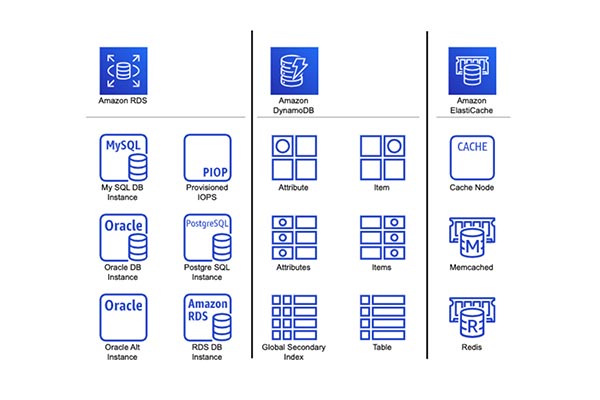An Overview of Amazon Web Services (AWS)
Amazon Web Services (AWS) is a dominant player in the cloud computing market, offering a vast array of services and resources to businesses and individuals worldwide. AWS boasts an extensive global infrastructure, ensuring high availability, scalability, and security for its users. Among the numerous services provided, databases on AWS stand out as a critical component for data management and analytics. AWS offers a wide variety of database solutions, including relational databases, NoSQL databases, time-series databases, and in-memory data stores, catering to diverse use cases and performance requirements.
The Importance of Selecting the Right Database on AWS
Selecting the appropriate database solution on AWS is crucial for ensuring optimal performance, cost-effectiveness, and long-term data management. The choice of a database significantly impacts various aspects of a project, including scalability, maintenance, and security. By carefully evaluating the specific use case, data type, and performance requirements, users can make informed decisions about the most suitable database on AWS. Factors such as cost, integration with other AWS services, and long-term data management strategies should also be taken into consideration when choosing a database on AWS.
Types of Databases on AWS
Amazon Web Services (AWS) offers a wide range of database solutions tailored to various use cases and data management needs. Here is a comprehensive list of database types available on AWS:
- Relational Databases: Amazon Relational Database Service (RDS) and Amazon Aurora are two popular relational databases on AWS. These databases support SQL-based querying and are ideal for applications requiring complex transactions and structured data.
- NoSQL Databases: AWS provides several NoSQL databases, including Amazon DynamoDB, DocumentDB, and Redis. These databases are designed for handling large volumes of unstructured data and offer flexible schema, high scalability, and performance.
- Time-Series Databases: AWS TimeStream is a fully managed time-series database that enables users to store, analyze, and visualize large volumes of time-stamped data. Time-series databases are particularly useful for IoT, monitoring, and observability applications.
- In-Memory Data Stores: Amazon ElastiCache is an in-memory data store that offers high performance and low latency for caching frequently accessed data. ElastiCache supports Redis and Memcached engines, providing users with flexible caching options.
By understanding the different types of databases on AWS, users can make informed decisions about the most suitable solution for their specific needs.
How to Choose the Best Database on AWS for Your Needs
Selecting the optimal database on AWS requires careful consideration of several factors. Here is a step-by-step process for choosing the best database on AWS:
- Assess Data Type: Determine the type of data you will be working with, such as structured, semi-structured, or unstructured. This will help narrow down your options to either relational or NoSQL databases.
- Consider Scalability: Evaluate your application’s scalability requirements. If you anticipate rapid growth, choose a database that can scale horizontally and handle increased traffic without compromising performance.
- Analyze Performance Requirements: Identify the performance metrics that matter most for your application, such as throughput, latency, and query speed. Select a database that excels in these areas.
- Evaluate Cost: Compare the pricing models of different databases on AWS, taking into account factors such as storage, compute, and data transfer costs. Choose a database that offers the best balance between performance and affordability.
- Consider Integration with Other AWS Services: Determine whether the database integrates seamlessly with other AWS services you plan to use. This will help streamline your workflows and improve overall efficiency.
- Plan for Long-Term Data Management: Ensure that the database supports your long-term data management strategies, such as data backups, archiving, and disaster recovery.
By following this process, you can choose the best database on AWS for your specific needs and ensure optimal performance, cost-effectiveness, and long-term data management.
Top Relational Databases on AWS
Amazon Web Services (AWS) offers several relational databases, including Amazon RDS and Aurora. These databases are ideal for applications requiring complex transactions and structured data. Here is a review of the top relational databases on AWS:
Amazon RDS
Amazon RDS is a managed relational database service that supports popular engines such as MySQL, PostgreSQL, MariaDB, Oracle, and SQL Server. RDS simplifies the setup, operation, and scaling of relational databases, allowing users to focus on application development. Key features of Amazon RDS include automatic backups, patch management, and replication for high availability and disaster recovery.
Amazon Aurora
Amazon Aurora is a high-performance, MySQL- and PostgreSQL-compatible relational database service designed for mission-critical applications. Aurora offers up to five times the throughput of standard MySQL databases and three times the throughput of standard PostgreSQL databases, ensuring exceptional performance and reliability. Additionally, Aurora provides automatic scaling, continuous backups, and multi-region replication for enhanced data durability and availability.
Both Amazon RDS and Aurora offer flexible pricing models, allowing users to pay only for the resources they consume. When selecting a relational database on AWS, consider factors such as performance, scalability, and cost to determine the best fit for your specific needs.
Top NoSQL Databases on AWS
Amazon Web Services (AWS) offers several NoSQL databases, including DynamoDB, DocumentDB, and Redis, designed for handling large volumes of unstructured data. Here is an analysis of the top NoSQL databases on AWS, highlighting their strengths, weaknesses, and applications:
Amazon DynamoDB
Amazon DynamoDB is a fully managed NoSQL database service that provides fast and predictable performance with seamless scalability. DynamoDB supports key-value and document data models, making it suitable for applications requiring flexible data structures and high throughput. Key features of DynamoDB include automatic scaling, built-in replication, and on-demand backup capabilities.
Amazon DocumentDB
Amazon DocumentDB is a managed document database service that emulates the APIs and features of MongoDB, allowing users to migrate their MongoDB workloads to AWS with minimal effort. DocumentDB offers high availability, automatic backups, and fast performance, making it an ideal choice for applications requiring document-based data models and MongoDB compatibility.
Amazon ElastiCache
Amazon ElastiCache is a fully managed in-memory data store service that supports Redis and Memcached engines. ElastiCache offers high performance, low latency, and automatic failover, making it suitable for caching frequently accessed data, session management, and real-time analytics. Key features of ElastiCache include multi-node replication, automated cluster management, and seamless integration with other AWS services.
When selecting a NoSQL database on AWS, consider factors such as performance, scalability, cost, and security to determine the best fit for your specific needs.
Emerging Databases on AWS: Time-Series and In-Memory Data Stores
Amazon Web Services (AWS) offers several emerging database types, including time-series databases (Timestream) and in-memory data stores (ElastiCache). These databases provide unique features, advantages, and limitations compared to traditional databases. Here is an exploration of these emerging database types on AWS:
Amazon Timestream
Amazon Timestream is a fully managed time-series database service that enables users to store, query, and analyze large volumes of time-series data. Timestream is designed for applications requiring real-time analytics, IoT telemetry, and financial data analysis. Key features of Timestream include automatic data retention, tiered storage, and serverless scaling, allowing users to optimize costs and performance.
Amazon ElastiCache
Amazon ElastiCache is a fully managed in-memory data store service that supports Redis and Memcached engines. ElastiCache offers high performance, low latency, and automatic failover, making it suitable for caching frequently accessed data, session management, and real-time analytics. Key features of ElastiCache include multi-node replication, automated cluster management, and seamless integration with other AWS services.
When selecting an emerging database on AWS, consider factors such as performance, scalability, cost, and security to determine the best fit for your specific needs. While these databases offer unique benefits, they may also have limitations compared to traditional databases. Ensure that the chosen database aligns with your application requirements and long-term data management strategies.
Best Practices for Managing Databases on AWS
Managing databases on Amazon Web Services (AWS) requires careful consideration of various factors, including performance, cost, security, and data integrity. Here are some best practices for managing databases on AWS:
Monitor Performance
Regularly monitor the performance of your databases on AWS to ensure they meet your application requirements. Utilize tools such as Amazon CloudWatch, AWS X-Ray, and RDS Performance Insights to gain insights into database performance and identify potential bottlenecks.
Optimize Costs
Optimize database costs by selecting the appropriate instance type, storage option, and scaling strategy. Utilize features such as Amazon RDS Reserved Instances, Amazon DynamoDB Reserved Capacity, and Amazon S3 Intelligent-Tiering to reduce costs without compromising performance.
Ensure Security
Implement robust security measures to protect your databases on AWS. Configure firewall rules, encrypt data at rest and in transit, and enable multi-factor authentication (MFA) for database access. Regularly review and update security policies to stay ahead of potential threats.
Maintain Data Integrity
Maintain data integrity by implementing backup and disaster recovery strategies. Utilize services such as Amazon RDS Backup, Amazon DynamoDB Backup and Restore, and AWS Database Migration Service (DMS) to create backups, replicate data, and migrate databases between different environments.
Scaling Strategies
Plan for scaling strategies to accommodate growth and changing requirements. Utilize features such as Amazon RDS Auto Scaling, Amazon DynamoDB Auto Scaling, and Amazon ElastiCache Auto Discovery to automatically adjust database resources based on demand.
By following these best practices, you can effectively manage databases on AWS, ensuring optimal performance, cost-efficiency, and data integrity.







